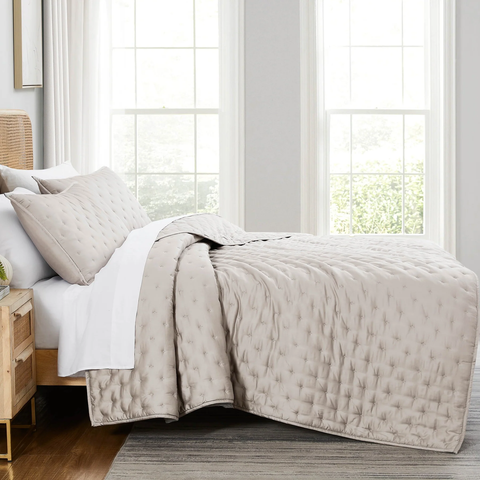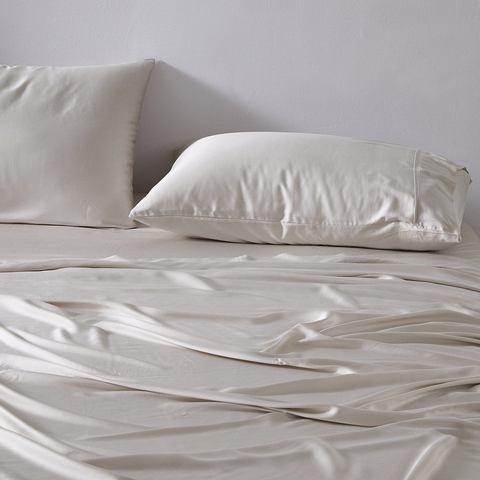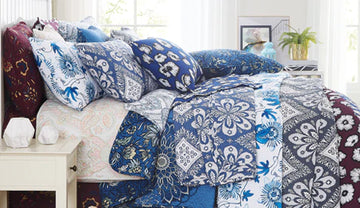Five Health Benefits of Bamboo Sheets and Bedding
According to the National Institute of Health (NIH), as many as one in three Americans report not getting enough sleep, and somewhere between 50 and 70 million people suffer from a sleep disorder. While there are a plethora of things that can lead to trouble sleeping, if your bedding is causing discomfort, you’re likely destined to toss and turn.

Bamboo may reign supreme when it comes to supremely comfortable bedding that contributes to your health. Bamboo is eco-friendly, breathable, and has hypoallergenic properties making it a great choice for most people. Keep reading to learn the five benefits of bamboo bedding.
Shop at Southshore Fine Linens for a high-quality and luxurious bamboo quilt set.
What Are the Benefits of Bamboo Sheets?
There are many health benefits and practical benefits of bamboo bed sheets. The top five benefits of bamboo bedding include:
1) The Biggest Benefit of Bamboo Sheets — They’re Hypoallergenic
Bamboo linens have been shown to have antimicrobial properties, which means they are less likely to harbor mold, dust mites, and other bacteria that can be harmful to those who may have sensitive skin and/or sensitive respiratory systems. This means bamboo sheets have been widely accepted as a hypoallergenic material ideal for those with allergies. While those with allergies and sensitive skin will benefit the most, anyone will be comfy, cozy, and breathing easy with bamboo bed sheets.
2) May Improve Skin Health
Bamboo’s antimicrobial properties, combined with its moisture-wicking ability, join forces to create a fabric that may lessen skin irritation (especially if you’re prone to acne, eczema, or other skin ailments). Using bamboo pillowcases with a sateen weave may aid a clearer complexion (assuming you’re washing your bamboo pillowcases regularly).
3) Can Keep You the Ideal Temperature for a Good Night’s Sleep
The Centers for Disease Control and Prevention (CDC) recommends sleeping in a cool room (somewhere between 60 and 67 degrees) with breathable bedding materials. Since bamboo is breathable and lightweight, it is an ideal fabric for keeping you cool and comfortable all night long. This, plus the fact that bamboo bed sheets tend to be just as soft (if not softer) than other natural fibers such as cotton, makes a good set of bamboo sheets an investment in optimally cozy.
4) Environmentally-Friendly
Many of us are concerned about not only our health but also the health of the planet. Another awesome benefit of bamboo bed sheets is that they tend to be one of the most eco-friendly options. This is because bamboo has a very fast growth rate and requires less water than cotton. Keep in mind that it’s important to research the company before purchasing bamboo bedding to ensure they adhere to ethical and eco-friendly business practices.
5) Bamboo Bedding Is Quite Durable
According to the Sleep Foundation, bamboo sheets can last up to five years when cared for properly. A case can also be made for bamboo’s durability and longevity, making it even more eco-friendly as you won’t have to replace it as often.
For bedding great for year-round use, check out this bamboo duvet cover from Southshore Fine Linens.
Are There Any Downsides to Bamboo Bedding?
When considering bamboo bedding, there are a few things to consider. For example:
- Price: Quality bamboo sheets can be pricier than some of the alternatives. Especially when shopping for bamboo sheets that are made ethically and eco-friendly. However, bamboo’s longevity tends to make up for the initial cost.
- Some wish it were softer: Some sheet sets may not be as soft as buyers prefer. For example, a lack of softness can be an issue if you invest in all-natural bamboo sheets. However, bamboo can be just as soft as cotton when processed properly.
- Wrinkles: Aesthetically speaking, bamboo can wrinkle easier than other fabrics, which is an issue for those desiring extremely neat bedding. However, this can usually be solved by removing the sheets immediately from the dryer or ironing them.
Bamboo Explained
According to the Sleep Foundation, the type of fabric and the type of weave are important to the feel and durability of bamboo sheets. Bamboo sheets are made from bamboo textiles that are woven into fabrics. These textiles are then used to weave together bamboo bedding.
Bamboo Textiles
Bamboo textiles include a process where the bamboo is made into pulp, soaked, dried, and then spun into fibers. The four most common types of bamboo textiles include:
- Rayon: Bamboo’s semi-synthetic alternative to silk. This process uses chemicals to regenerate cellulose that is turned into the pulp. Rayon tends to be an affordable bamboo textile.
- Viscose: Viscose from bamboo is a type of rayon that also uses harsh chemicals to create the pulp. When not handled properly, these chemicals can pose an environmental risk and a health risk to workers dealing with the chemical.
- Lyocell: Uses a chemical process to create the pulp, but it’s a non-toxic chemical process
- Bamboo linen: Uses an all-natural process done by hand to naturally excrete enzymes through a mechanical process. This option tends to be the most expensive, resulting in a fabric that isn’t as soft as the alternatives.
The Most Common Types of Weaves With Bamboo Sheets
The Percale Weave
This weave creates a firm and lightweight feel with a matte-like appearance by using a simple one-thread over, one-thread-under pattern.
The Sateen Weave
This weave uses a more complex one-over, three to four threads under weave. Much like the name suggests, sateen weave sheets have a silk-like feel and appearance. Sateen is less likely to wrinkle but is more likely to pill over time and hold in more heat (which may be an issue for some).
The Twill Weave
This weave uses a diagonal parallel rib weave. This allows for a textured look in the fabric and makes it very durable. Keep in mind that you give up some of the softness for durability with this weave.
FAQs

Are Bamboo Sheets Good for Hot Sleepers?
Yes. Bamboo sheets can be ideal for hot sleepers as they regulate body temperature by being lightweight and breathable.
Can Bamboo Still Be Stylish?
Absolutely! Bamboo textiles are actually known for holding onto dye better than alternative fabrics. This means the color(s) are less likely to fade over time. Plus, you can find bamboo bedding in various designs ranging from neutral and natural to whimsical and colorful. For example, these bamboo quilted sham sets range from simple to colorful and unique.
What’s Better: Cotton or Bamboo?
Regarding bamboo vs. cotton, personal preferences are usually the key to making the best choice. Both bamboo and cotton are very soft (depending on the thread count), made of natural fibers, and they are both breathable and durable. According to the Sleep Foundation, bamboo bedding is better for those with sensitive skin, those who care about renewable resources, and those who prefer vivid colors that won’t fade as quickly over time. Cotton may be preferable for those who already suffer from night sweats.
When finding the right bedding, we often only think of what is the most comfortable. While this is, of course, an extremely important element of great bedding, it isn’t the only factor worth considering. It is wise to also consider longevity, style, and what provides the most benefits to your health and lifestyle. Bamboo bedding tends to be a great option for those desiring bedding made out of eco-friendly materials that are durable and health-conscious while still being comfortable.
For affordable luxury bedding, shop at Southshore Fine Linens.
Sources:
Aliona, R. (2022). BAMBOO FIBER ANTIBACTERIAL EFFECT (A REVIEW).Caruso, C. (2020). Improve Sleep: Tips to Improve Your Sleep When Times Are Tough.
Emamverdian, A. (2020). Application of Bamboo Plants in Nine Aspects.
Foley, L. (2023). Bamboo vs. Cotton Sheets: Which Should You Choose?
Noyed, D. (2023). Best Bamboo Sheets.
What Are Sleep Deprivation and Deficiency? (2022).



